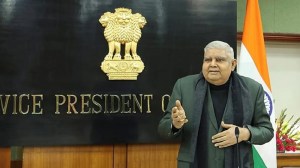AI-powered traffic signals reduce travel time by up to 33% in Bengaluru, shows data
The AI-powered system, launched in May 2024, currently covers 60 junctions in Bengaluru and is part of a broader plan to modernize traffic management in a city notorious for its congestion.
 The increased efficiency has led to higher hourly throughput, with traffic moving more smoothly and consistently than under the previous manual traffic management system.
The increased efficiency has led to higher hourly throughput, with traffic moving more smoothly and consistently than under the previous manual traffic management system.Data shared by Bengaluru’s Joint Commissioner of Police (Traffic) M N Anucheth showed that the city’s newly implemented Adaptive Traffic Control System (BATCS) has significantly improved traffic flow, reducing travel times by up to 33 per cent at key junctions across the city.
The AI-powered system, launched in May 2024, currently covers 60 junctions and is part of a broader plan to modernize traffic management in a city notorious for its congestion.
The BATCS, which combines the power of real-time data collection and AI-driven analytics, adjusts traffic signal timings dynamically to match current traffic volumes. “Unlike older, fixed-time traffic control systems, the adaptive system responds to changing traffic conditions at each intersection. This has reduced unnecessary delays and optimized traffic flow, particularly during peak hours,” said Anucheth.
Early results show major reductions in travel time
Since its partial implementation, the BATCS has already demonstrated significant results. Key corridors such as K R Road and Jayanagar have seen reductions in travel time by up to 20 per cent, while the system’s most significant improvements were noted at Hudson Circle, where travel times decreased by 33 per cent.
In addition, the increased efficiency has led to higher hourly throughput, with traffic moving more smoothly and consistently than under the previous manual traffic management system.
For instance, in areas like K R Road and Hudson Circle, hourly throughput saw increases of up to 18 per cent and 30 per cent, respectively. This means more vehicles are moving efficiently through these junctions within a given hour, reducing congestion and improving travel times.
Junctions that previously suffered from bottlenecks, such as Halasuru Gate and Police Corner, also reported marked improvements, claimed Anucheth. “Travel times through these areas are now more reliable, offering commuters smoother journeys with fewer stops and quicker passage through typically congested zones,” said the commissioner.
AI-Powered Optimization and Real-Time Monitoring
The BATCS system stands out due to its real-time adaptability. Traffic signal timings at the 60 upgraded junctions are adjusted dynamically based on the volume of vehicles, monitored through camera sensors at each junction approach. This real-time data enables the system to create a more accurate and efficient flow of traffic.
For example, signals along major corridors are synchronized, forming “green waves” that allow vehicles to move uninterrupted for longer stretches, reducing the number of stops and improving travel times. The system operates with minimal manual intervention, with more than 90 per cent of signal adjustments occurring automatically through AI, explained Anucheth.
The centralized control room allows the Bengaluru Traffic Police to monitor the performance of each signal, making quick adjustments when necessary. “Emergency vehicles also benefit from the system, which can give priority to ambulances and fire trucks, ensuring they navigate the city’s streets with minimal delays,” said Anucheth.
Comparing BATCS with traditional traffic systems
Unlike traditional traffic control systems, which relied heavily on manual input and fixed-time signal operation, the BATCS is designed to address the unpredictable nature of Bengaluru’s traffic. The city, which has more than 14 million residents and over 12 million registered vehicles, often struggles with traffic that varies significantly depending on time of day, construction activities, and sudden incidents.
The older systems, which required frequent manual adjustments by traffic police, were insufficient to handle this complexity. In contrast, the BATCS relies on real-time traffic data, making it more responsive to the city’s diverse and evolving traffic patterns. “This allows for more reliable travel times, better fuel efficiency, and reduced pollution as vehicles spend less time idling at signals,” said Anucheth.
AI-powered signals in 165 junctions by 2025
The 60 junctions currently upgraded are just the first phase of the BATCS project, which will eventually cover 165 junctions by January 2025, Bengaluru traffic police said. Following that, the system will be expanded to cover an additional 400 junctions across the city.
Bengaluru Traffic Police aim to make the BATCS a city-wide solution that enhances traffic flow, improves safety, and ensures more reliable travel experiences for all road users. Preliminary results indicate that once fully implemented, the BATCS will deliver widespread benefits.
The Bengaluru Traffic Police, in partnership with Bruhat Bengaluru Mahanagara Palike (BBMP), has also ensured that the system will complement other infrastructure projects, such as road widening, flyovers, and tunnels. “The BATCS will work in synergy with these initiatives, creating a more holistic and integrated traffic management system for the city. As the system continues to roll out, we urge public cooperation during the ongoing installation and testing phases. While there may be temporary disruptions, the long-term benefits of the BATCS, including smoother travel and reduced congestion, are expected to transform the city’s traffic management landscape,” said Anucheth.












